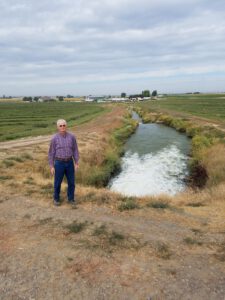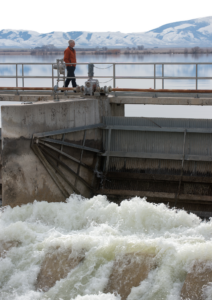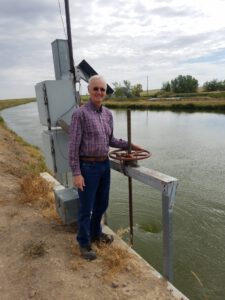As in most parts of rural America, agriculture reigns supreme in southern Idaho. The area receives around 10 inches of rain and 19 inches of snow per year, but a substantial amount of water is required to ensure that traditional crops, such as corn, barley, potatoes, and beets, can flourish. Since 1903, the Twin Falls Canal Company has been providing water to the farmers, municipalities, and individuals who live in the more than 202,000 acres of land it services. Kris Polly, editor-in-chief of Irrigation Leader, spoke with Brian Olmstead, general manager for the Twin Falls Canal Company, about issues affecting the Twin Falls Canal Company today, the 2015 Idaho Groundwater Settlement, and how Mr. Olmstead will prepare the canal company for future growth.
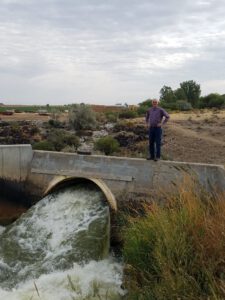 Kris Polly: Please tell us about yourself and how you became general manager of the Twin Falls Canal Company.
Kris Polly: Please tell us about yourself and how you became general manager of the Twin Falls Canal Company.
Brian Olmstead: I was born and raised in Twin Falls, Idaho, on a family farm, and I received my bachelor of science degree in animal science from Utah State University in 1975. After graduating, I returned to the farm and married my wife, Stephanie, and we had three daughters. I farmed on the family farm south of Twin Falls for about 25 years until 2000, when I decided to try something different.
We had reached a point at which we either had to grow the farm or choose a different profession because we were not making enough money to keep it profitable. We decided to lease the farm to a beet and potato grower, and we are still doing that. I applied for a job here at the Twin Falls Canal Company and was hired as a field supervisor. When I began, we were working hard on the total maximum daily load/water quality issues, safety violations, and some difficulties with the growth of subdivisions. I worked directly under the general manager at the time, Vince Alberti. From 2000 to 2008, I worked directly under him and with all the crews, which gave me a good view of the overall operation. I was hired as general manager after he retired, and this is now my 11th year as general manager. Vince tells me that I am the luckiest man he knows because he had several severe drought years during his tenure, and I have not had one yet.
Kris Polly: What is the history of the Twin Falls Canal Company?
Brian Olmstead: We are the largest canal company in Idaho and one of the larger ones in the United States. The Twin Falls Canal Company was formed in 1900 by I. B. Perrine, an early settler, who filed a claim under the Carey Act. He got the 202,000 acres and the 3,000 cubic feet per second out of the Snake River when he filed. The Snake River was pretty well allocated above Blackfoot at that time, because the early Mormon pioneers had already filed on most of that land. Mr. Perrine was the first to apply for a large diversion below Blackfoot.
He built Milner Dam in 1904 and 1905, which he immediately began to divert out onto the farm country. The river generates a lot of additional water from Blackfoot on down in the form of spring flows. The system worked well: The land laid off in the right direction at a 1 percent slope generally, so gravity irrigation worked and that is why we still use it today. A lot of the farmers have converted to sprinklers, but not to the extent that the other districts in our area have. When I started in 2000, only about 15 percent of our customers used sprinklers. We are changing that by about 2 percent per year, or about 4,000 acres per year. Now, we are over 50 percent sprinkler-irrigated; the rest is still on gravity irrigation.
Kris Polly: What kind of crops do area farmers grow?
Brian Olmstead: We grow a wide range of products in the area, mostly to supply dairy cattle. We grow a lot of corn, alfalfa hay, potatoes, sugar beets, barley (used by Coors and Budweiser), and wheat. There are several fairly large dry bean packaging companies in the valley, so pinto, pink, and garden beans are large crops as well.
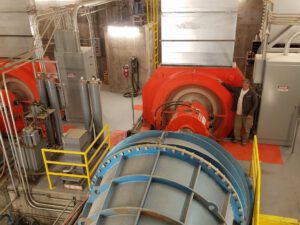
Kris Polly: How many people do you serve?
Brian Olmstead: We serve over 202,000 irrigated acres, and with few exceptions, each acre has one share of Twin Falls Canal Company stock. We try to keep it that way. If the farm sells, the water stays with it. If the land goes into a rural subdivision or is annexed by the city of Twin Falls, the water stays with the land to be used for landscaping irrigation. We have about 5,000 stockholders, and of those, roughly 500 are active production farms doing 80 acres or more. Our largest two stockholders are the Church of Jesus Christ of Latter-Day Saints, which has about 5,000 shares, and the City of Twin Falls; the city is our largest stockholder because it has expanded significantly. The city, through annexation, has acquired over 5,000 shares. The city delivers those to all the new parts of town through pressure irrigation systems. In addition to serving individual farmers, we deliver to 25 pressure irrigation systems owned by the city. The city tries to use its potable water for domestic uses and keep all landscaping irrigated with canal water. Even with all the new development, about 95 percent of our water still goes to farmers.
Kris Polly: How much do you rely on groundwater?
Brian Olmstead: About two-thirds of our water comes from the Eastern Snake Plain aquifer. Annually, we divert just over 1 million acre-feet of water through our canal. We are a surface water canal, with efficiency somewhere around 50 to 60 percent; the farmers do not get the whole million acre-feet, but they get roughly 4 acre-feet per acre delivered to them. We have 250,000 acre-feet of storage water in the Jackson Lake and American Falls reservoirs, which is about a quarter of our water supply. Another quarter is from the flood flows from the snow runoff in May and June. The other half of our water comes from spring flows returning to the river between Blackfoot and Milner. We are first in priority for any water that returns to the river below Blackfoot, so about 2,000 cubic feet per second of our water is natural flow that is derived from Eastern Snake Plain aquifer return flows. Essentially, we are using the same resources that the groundwater members use, even though we do not own a single pump.
Kris Polly: How effective do you think the Idaho Groundwater Settlement was?
Brian Olmstead: I think that it is a fabulous agreement. Water users throughout the Eastern Snake Plain aquifer fought for about 15 years before reaching this agreement. Before 1960, there were roughly 1 million acres of surface irrigation and very little groundwater irrigation. Then, with surplus power and lots of land available, the state of Idaho and farmers developed about 1 million acres of groundwater irrigation with deep wells. So, the water the groundwater users were taking was the same water that we were relying on to supply the spring flows. We didn’t want to put groundwater farmers out of business, but in the West, there are two kinds of water users: those who fought for their water, and those who do not have any water. We were all just trying to protect our own interest. Groundwater farmers wanted to keep their farms going, and we wanted to keep our water secure. We were tired of fighting and decided that this agreement was needed to manage our water and sustain all parties into the future.
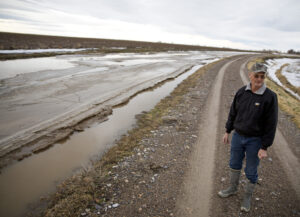
The aquifer is truly our biggest reservoir. According to hydrologists, the usable capacity is around 11 million acre-feet. Although no one thinks we can get it back to the level it was in 1960, we think we can get it back to where it was in the 1990s. The Idaho Groundwater Settlement is a plan to sustain and effectively manage groundwater and keep everyone in business. The only way to restore water to the aquifer is through recharge or reduced pumping, and the agreement finds a balance between the two. Groundwater users agreed to the 13 percent reduction, and the state agreed to 250,000 acre-feet of annual recharge. In the good years, we try to recharge 500,000 acre-feet or more if we can, and in the bad years, we should be able to recharge about 100,000 acre-feet. According to all the modeling, within 10 years we will have the Eastern Snake Plain aquifer back to where it was in the 1990s. It is hard to say at this point whether there may be room for new water development if we ever get the aquifer restored. That will be a decision for future water managers.
Kris Polly: What are some of the biggest challenges you face on a day-to-day basis?
Brian Olmstead: Recently, we made a big switch from gravity-fed irrigation to sprinkler irrigation. That conversion has caused us some difficult water management challenges. Another is our total maximum daily load/ water quality challenge. Because we are still around 40 percent gravity irrigation, we have a lot of mud entering our system and washing off our system into the river. With the Clean Water Act and the total maximum daily load, agriculture is non-regulated, but people still expect us to get that mud out of the river. We have built a lot of wetlands and other facilities to capture our return flows to keep the river clean.
Water conservation is another challenge we are constantly working on. We understand that we cannot just expect the groundwater users to cut by 13 percent and not make conservation improvements ourselves. For the benefit of everybody, any water I can save stays in the reservoir system, where it will help fill the reservoirs or be used for aquifer recharge. We want the agreement to work, so as a result we always want to conserve as much water as possible. We have automated a lot of our deliveries. We are encouraging the conversion to sprinklers, which are somewhat more efficient. We have built a large re-regulating reservoir to keep from wasting so much off the bottom end, and we are continuously installing new pipelines.
The most ambitious conservation project we are planning is a system of automated check structures for our main canals. Our canal was built in 1903, basically with horses and scrapers, and was designed to run full. When it is not running full, it does not run efficiently. The best way to have it run efficiently with less water is to install a series of check structures integrated with a significant amount of technology. To send water 66 miles down a canal, I have to plan 2 or 3 days ahead to get the water there, but if I had automated check structures throughout the whole canal, I could manage more in real time because it would be stored throughout the canal. We are hoping to get some grants and loans to speed up this important project. We need to be more efficient than we are.
We are also dealing with rapid residential growth. We do not want to be a canal company that has a subdivision built at the bottom at the bank and has canal failure. We are working really hard to protect our 50-foot rights-of-way on the big canals, 30-foot rights-of-way on the medium-sized ditches, and at least 16-foot rights-of-way anywhere. We do not want open ditches running through anyone’s backyard, so we now require developers to pipe subdivision ditches. A member of our team serves on the zoning board and spends a lot of his time at zoning meetings. We need to know where every development is and ensure that they know about and respect our rights-of-way.
Aquatic weed management is a constant challenge for us. There are new weeds all the time. Weeds become resistant, and we have new restrictions on chemicals. Everyone really needs to stay on top of their weed management. We rely on aquatic herbicides for most of our problems, but we still keep our large anchor chains and pull them occasionally when modern methods don’t work.
One problem that is getting worse for us is the northern virile crayfish, an invasive crawdad that has arrived in our area. We have always had crawdads in our system, but the native ones died in the winter when we dewatered the canals. These new ones burrow deep and survive the winter. They can get out of the water and travel 100 yards to another ditch. They are resistant to aquatic chemical products as well. They do not block the water, but they do block our farmers’ pumps, screens, and gated pipes. They burrow to such an extent that we have lost some check structures; their burrowing is similar to a bunch of gophers digging around them.
Kris Polly: What words of wisdom do you have for your peers?
Brian Olmstead: I think you need to manage water 10 to 20 years out. You have to be looking ahead and thinking about what the canal system will look like in the future. Once you get behind, you cannot catch up. This applies to development in your area or to regulations such as the Clean Water Act. You must constantly strive for efficiency. We put a lot of effort into trying to protect our water supply. I have not heard of anyone who thinks they will have a better water supply in the future than they do now, so you have to plan for less water. Figuring out the most efficient ways to deal with that is imperative.
Brian Olmstead is the general manager of the Twin Falls Canal Company. He can be reached at olmstead@tfcanal.com.

